List of World War I memorials and cemeteries in the Argonne
The Forest of Argonne contains many World War I memorials and cemeteries, relating to the United States, French and German armies.
War Memorials and Cemeteries: The Argonne
The Meuse-Argonne Offensive
The Meuse-Argonne Offensive in September 1918 was part of the Allied effort to force the Germans to retreat and hopefully move them out of France and plans included taking maximum advantage of the arrival of the American Expeditionary Force under General Pershing. After four years of fighting, European soldiers were understandably exhausted, but the arrival of the U.S. Forces gave the Allies fresh troops and importantly a numerical superiority. Until the last great German offensive of 15 July was successfully repulsed and a successful U.S.-French counter-offensive was launched at Soissons on 18 July the Germans had made significant advances in 1918 but now they were on the defensive and the Allied task was to now keep them so.
The U.S.First Army had already been successfully employed in the St Mihiel sector and eliminated the German salient there and the Allied plan was to now mount a major offensive of which St Mihiel had only been an appetiser.
As part of this major offensive, the Americans were allocated the area between the Argonne Forest and the Meuse River. This was a key area for the Germans. The lateral communications between German forces east and west of the Meuse were in this area and the Germans were heavily dependent upon two rail lines that converged in the vicinity of Sedan which lay just 35 miles from the front line. The nature of the terrain over which the Americans were to fight was ideal for defence and conversely difficult to attack. On one side was the heavily wooded and tangled Argonne Forest and the Aire River which presented natural obstacles and on the other the Meuse River and the Heights of the Meuse from which the Germans could observe the battlefield and cover it with artillery fire
Between the Aire and the Meuse Rivers there were a series of ridges that afforded excellent observation. First, there was the hill at Montfaucon, behind that the Heights of Romagne and Cunel and beyond these were the Barricourt Heights and to protect this vitally important area, the Germans had established defensive positions some 10 to 12 miles deep.
The plans were for the 600,000 man strong U.S.First Army to attack northward with nine divisions in the line and five in reserve, these supported by 2,700 pieces of artillery, 189 tanks, and 821 aircraft. The attack would take place along a fifteen- to twenty-mile-wide corridor bounded by the Meuse River on the east and the dense Argonne Forest and the Aire River on the west.
The Germans had occupied the area for years and in that time had developed an elaborate defensive system of four fortified lines with a dense network of wire entanglements, machine-gun positions, and concrete fighting posts. In between these trench lines, the Germans had added a series of strong points in the woods and knolls. With five divisions on the line and another seven in reserve, French General Philippe Petain believed that the German defenses were so strong that the Americans would do well if they managed to reach one of their first objectives, the town of Montfaucon, located a few miles behind enemy lines, before winter.
At 05:30 hours on 26 September 1918, after a three-hour artillery bombardment, Pershing launched his attack.
Despite heavy fog, rugged terrain, and the network of barbed wire, American soldiers quickly overran the Germans’ forward positions but thereafter progress was slow with heavy rains having turned the terrain to mud, bogging down tanks and artillery and slowing resupply efforts. The Germans used the delay to bring in reinforcements, and German artillery rained down fire from the heights of the Meuse and the Argonne Forest. The advance became a continuous series of bloody, hard-fought engagements and of the nine U.S. divisions used in the initial assault, only three had any significant combat experience. Indeed, the 79th Division had only been in France for seven weeks.
Despite these problems, by 30 September, the First Army had managed to advance as far as six miles into the German lines in some places, fighting through some of the strongest positions on the Western Front and capturing 9,000 prisoners and large amounts of supplies and equipment.
As the battle progressed, Pershing began to reorganize the First Army, rotating three battle-hardened divisions into the line to relieve some of the less experienced units. The Germans also strengthened their position, adding six new divisions, bringing their total to eleven.
On 4 October, the First Army renewed the attack. The fighting was especially severe but the critical high grounds remained in German hands. As new American divisions were rotated into line, the Germans continued their reinforcement efforts; and by 6 October, they had twenty-seven divisions in the area.
By the third week of October, the First Army had penetrated the third German defensive line and were able at last to clear the Argonne. Pershing reorganized the AEF, creating the Second Army under General Robert L. Bullard. Pershing later placed General Hunter Liggett in charge of the First Army, in order to focus his own attention on larger strategic issues.
To prepare for the second phase of the offensive, Liggett ordered a series of limited attacks to keep the pressure on the Germans while his battle-weary men reequipped and recuperated and by the end of October, the 1st Army was ready for the next general attack.
On 1 November, Liggett's First Army attacked north, toward the Meuse River. Over the next several days, the First Army advanced as fast as it could move artillery and supplies forward. At one point, the advance was so rapid that it ran off the AEF headquarters’ maps. By 4 November, the Americans had achieved their objective and the German army was in full retreat on both sides of the Meuse and three days later the heights overlooking Sedan were taken and the U.S. First Army was able to gain domination over the German railroad communications there.
One week later the armistice was signed, and World War I was over. Almost 1.25 million American troops had participated during the course of the 47-day campaign. American casualties were high—over 117,000—but the results were impressive. The U.S.First Army had driven forty-three German divisions back about thirty miles over some of the most difficult terrain and most heavily fortified positions on the Western Front, while inflicting over 120,000 casualties. The Meuse-Argonne Offensive was the greatest American battle of the First World War and In six weeks the AEF lost 26,277 killed and 95,786 wounded.
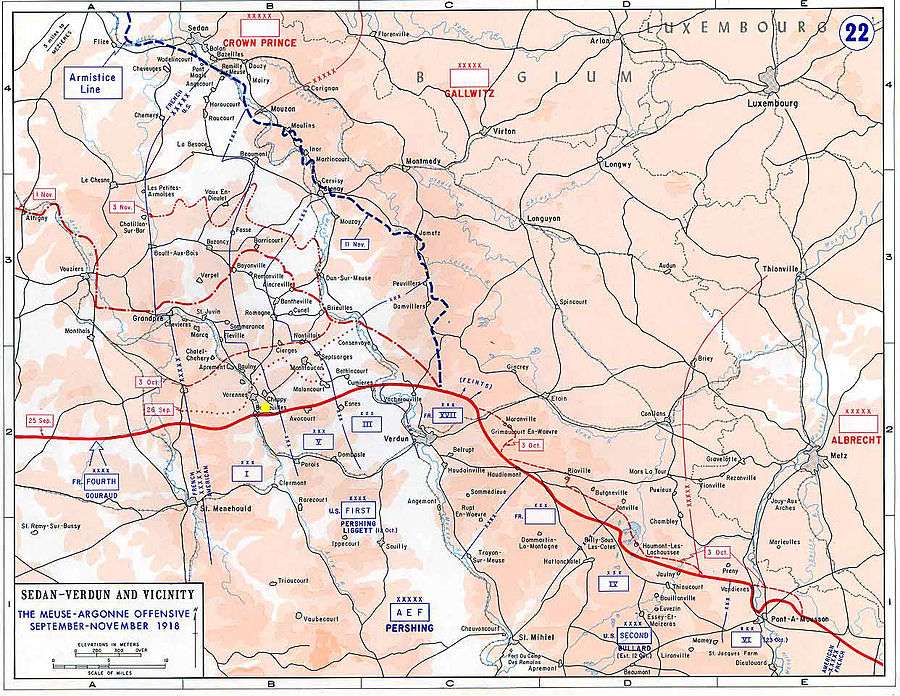
The Meuse-Argonne American Cemetery
By the small village of Romagne-Gesnes and not far from the Montfaucon Memorial is the largest American Cemetery in Europe; the Meuse-Argonne American Cemetery which covers 52 hectares. As with all American war memorials and cemeteries it is maintained by the American Battle Monuments Commission.
The cemetery was started in October, 1918, in the area captured by the US 32nd Infantry Division. The architects were York and Sawyer of New York. The cemetery holds 14,246 graves including 486 unknown soldiers and panels on the walls of the Memorial Chapel record the names of a further 954 men whose bodies were never found; as the inscription above their names so aptly states- "whose earthly resting place is known only to God". A stone wall more than 1.1/2 miles long encircles the cemetery.
The memorial is a fine example of Romanesque architecture and consists of a chapel and two flanking loggias on the walls of which are listed the names of those missing in the area as well as those missing whilst serving in northern Russia. The memorial's exterior walls and columns are of Euville Coquiller stone and the interior walls are of Salamandre travertine.
High above the main entrance to the chapel is the inscription
"Dedicated to the memory of those who died for their country"
and on the lintel is written
"In sacred sleep they rest"
There is a bas-relief by Alfred-Alphonse Bottiau carved into the tympanum with figures representing Grief and Remembrance.
Across the ends and front of the loggias above the arches are names of places in the region where the U.S.forces fought- "PONT-MAUGIS-BOIS DE CUNEL-MEUSE-CIERGES-BOIS DES RAPPES-CONSENVOYE-EXERMONT-GRANDPRE-MEUSE HEIGHTS-BARRICOURT HEIGHTS-GESNES-MONTFAUCON-CORNAY-BOIS DE FORET-STENAY-ARGONNE-CHEPPY-COTE DE CHATILLON".
In the chapel there are stained-glass windows by Heinigke & Smith of New York which show the insignia of the American Divisions and larger units which made up the American Expeditionary Force.[1]
The Monument at the Butte de Vauquois
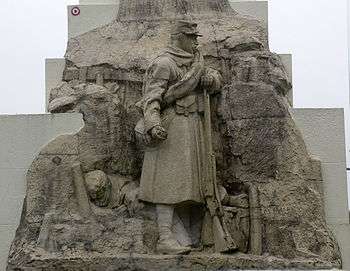
In the novel "Birdsong", Sebastian Faulks relates the activities of tunnellers on the Western Front, and at Vauquois, we have an area that was riddled with tunnels and saw both French and German engineers and sappers constantly at work.
The Butte de Vauquois is a small hill, 290 metres high, which dominates the valley between the Argonne massif to the west and the Mort Homme/Hill 304 massif to the east. It allowed good observation in every direction, particularly the Islettes pass leading to Verdun and consequently both German and French Armies were anxious to hold it.
The Germans first occupied the ridge on 24 September 1914 and subsequently turned it into a fortress supported and flanked by artillery positioned in the woods around Cheppy and Montfaucon.
Between 28 October 1914, and 28 February 1915, the French made four unsuccessful attacks to remove the Germans from the hill and finally took the German trenches on 1 March 1915 and for the next few days managed to fight off constant German counter-attacks.
Fighting continued throughout 1915 but neither side made a breakthrough and the front line ran through the village itself. Gradually the two sides decided to abandon hand-to-hand fighting from the trenches and resorted to digging and setting off explosive mines underneath the hill and a total of 531 mines, either French or German, were detonated, the largest being that of 60 tons which in May 1916 removed the church and 108 men with it. Bit by bit, explosion by explosion, the village of Vauquois was blown to smithereens and what we see today are a series of massive craters which had effectively split the Butte in two. It is estimated that 8,000 French and German soldiers went missing on the hill and their bodies were never found. Today public notices tell you that this was where the church stood, or the town hall, etc.etc.
The American Expeditionary Force finally cleared the hill on the first day of the Meuse-Argonne Offensive on 26 September 1918.
At the summit of what was the French side of the butte is the memorial to those Frenchmen who fought and died at Vauquois. This consists of an obelisk in the shape of a "Lantern of the Dead" and on one side of the obelisk there is a sculpture of a French Infantryman with grenade in one hand and rifle in the other. Behind him is a carving of the trunk of a mutilated tree. This represents an actual tree which used to stand on almost the same spot as the monument, and which was used as a "marker" by the French artillery. At the infantryman's feet we see another soldier, this one a tunneller, who is sleeping on the floor of a trench.
The monument, which stands on the site of the old town hall, was designed by the Paris architect Edouard Monestès and the sculptural work was by Marius Roussel.[2]
One victim of the fighting at Vauquois was the politician Henri Collignon, who enrolled in the Army at the age 58 and a small memorial in the area is dedicated to him.
Missouri First World War Monument at Cheppy

The Missouri First World War Monument at Cheppy is dedicated to the men of Missouri who gave their lives during World War I. It is located at the road junction, south of the town of Cheppy . It comprises a stone pedestal with a bronze "Angel of Victory" figure on the top. This stands in a walled area reached by a series of steps. It was erected in 1922 by the State of Missouri. A photograph of the bronze statue is included in the gallery at the end of the article and below we see a German military map of the area dating to 1917.[3]

The Montfaucon Monument
The Montfaucon monument rises 200 feet above the ruins of the former hilltop village of Montfaucon and dominates the surrounding countryside. Before its capture on 27 September 1918 by the American 37th and 79th Divisions as part of the Meuse-Argonne Offensive, the hilltop had served the German forces well as an ideal observation point.
The Montfaucon American Monument commemorates not only the American victory but also the heroic efforts in the region of the French army in the previous years of the war. It is maintained by the American Battle Monuments Commission.
The architect was John Russell Pope of New York and the 180 foot shaft is of Baveno granite and takes the form of a Doric column surmounted by a figure symbolising "Liberty". It faces the U.S.First Army's line of departure on 26 September.
The names of the four most important areas captured by American troops appear in large letters across the front of the monument. These are
"MEUSE HEIGHTS,BARRICOURT HEIGHTS, ROMAGNE HEIGHTS AND ARGONNE FOREST"
Inside the monument's vestibule one can read a full account of the battle and there is a map of the Meuse Argonne offensive in polished marble. There is also the text of a tribute by General Pershing to his men and on the wall which surrounds the main terrace are listed the divisions which made up the U.S.First Army and the names of the places where they fought.
The observation platform on top of the memorial can be accessed by a circular stairway of 234 steps but it does afford superb views of the battlefield area.
The monument was inaugurated on 1 August 1937, in the presence of the President of the French Republic, Albert Lebrun and Generals Pétain and Pershing and Franklin Roosevelt, then the President of the United States, delivered a radio address for the ceremony beamed from Washington.
Just by the monument are the ruins of Saint-Germain Abbey thought to date back to the 6th century and in the gallery at the end of the article there is a photograph showing both the American column and part of the abbey's ruins.[4]
The Pennsylvania Memorial at Varennes en Argonne
The Pennsylvania Memorial was erected by the State of Pennsylvania in 1927 to honor her sons who gave their lives in France. It was constructed in the Greek style.[5][6]
%2C_just..._-_NARA_-_530760.tif.jpg)
The Monument and Ossuary of La Haute Chevauchée. The Memorial to the Defenders of the Argonne
The monument of the Haute Chevauchée is dedicated to the memory of those men who were killed in the Argonne. It was designed by the architect Bolloré and inaugurated on 30 July 1922 by Raymond Poincaré and blessed by Monseigneur GInisty, the Bishop of Verdun.
Not far from the monument is the "Cross of Reconciliation" erected in 1973 by the "Comité Commémoratif d'Argonne" in a gesture of Franco-Germsn reconciliation.
The 9-metre-high (30 ft) stone monument is surmounted with the bust of a soldier whose hands clasp the handle of a sword which overlays a cross. The flanks of the memorial are engraved with the numbers of the 275 French regiments, 18 Italian Regiments and 32 American Divisions who saw service in the Argonne Sector. The crypt of the memorial contains an ossuary containing the remains of several thousand unknown soldiers. There is an altar at the base of the monument for ceremonial use. The sculptor Becker had based the soldier's face on that of his son who had been killed in 1915.[7]
The Ossuaire de la Gruerie and the French National Cemetery at St Thomas-en-Argonne
This is located opposite the French National cemetery at St Thomas-en-Argonne and was created in 1923 when the remains of approximately 10,000 unknown soldiers were discovered when the area around La Biesme and the woods of la Gruerie was cleared after the war.
The St Thomas-en-Argonne cemetery holds the bodies of 8,085 French soldiers of whom 3,324 were placed in two ossuaries. The monument to the 128th French Infantry is located in this cemetery.[8]
Romagne-sous-Montfaucon German Cemetery
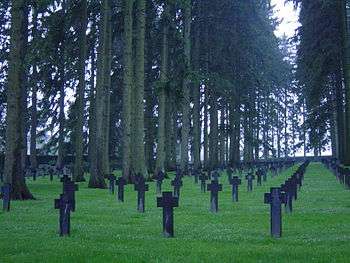
In Romagne-sous-Montfaucon there is a cemetery containing the graves of 1412 German and 4 French soldiers. It was begun by the Germans in August 1914 after heavy fighting in the area. A number of military hospitals were set up in the area all of which required a suitable burial ground for those whose lives could not be saved. The entrance to the cemetery is worth entering to see the mosaic shown below which is entitled "Hier Ruhen Deutsche Soldaten": "Here lie German soldiers". See photographs in the gallery at the end of the article which include the mosaic, the entrance itself and some of the German graves. [9]
The Kaiser Tunnel
It was after the First Battle of the Marne that the German 5th army chose the Argonne forest as the defence line to halt the advance of the 3rd French army and the Germans were to turn the area into one of their best defended positions. It was in November 1915 that the Germans created the Kaiser tunnel complex which comprised several kilometres of galleries and connecting tunnels. This was one of many tunnels and was a reaction to the realisation at that time that a breakthrough was not going to be achieved and that the war would also need to be waged underground as well as on the surface. Eleven tunnels were dug on the German side and thirteen on the French side.
The Kaiser tunnel was used for more than two years until 24 September 1918 when the Germans retreated taking all equipment and material with them before blowing up all the tunnel's exits.
The Kaiser tunnel was one of eleven created by the Germans which crossed the Haute Chevauchée and allowed soldiers to live in relative security. These tunnels housed combatants, provisions and arms and munition and could also be used to ferry injured men away from the front. The Kaiser tunnel was created by Bavarian troops without help from engineers and its main artery was 350 metres long and contained galleries with a total length of 425 metres. It led on to the "Bataillon Tunnel" in the south and the Ortlieb-Tunnel leading north. The three tunnels had a total length of 800 metres. Generators were installed to allow the supply of electric lighting and there were ventilators, numerous pumps and even a telephone system in the northern section. There was also a hospital facility with sixty beds and an operating theatre. [10]
Gallery
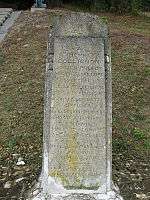 Monument dedicated to Henri Collignon at the foot of the Butte de Vauquois.
Monument dedicated to Henri Collignon at the foot of the Butte de Vauquois.- Small German cemetery on Meuse-Argonne battlefield.
 The monument at Vauquois shaped like a "Lantern of Death"
The monument at Vauquois shaped like a "Lantern of Death" Entrance to German War Cemetery at Romagne-sous-Montfaucon.
Entrance to German War Cemetery at Romagne-sous-Montfaucon.- Ruined church at Montfaucon-d'Argonne directly behind the monument. The structure on the left is a German World War I observation post.
 Eagle at entrance to the Meuse-Argonne American Cemetery.
Eagle at entrance to the Meuse-Argonne American Cemetery.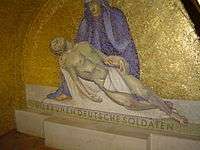 Pieta in mosaic in entrance to Romagne-sous-Montfaucon German War Cemetery.
Pieta in mosaic in entrance to Romagne-sous-Montfaucon German War Cemetery.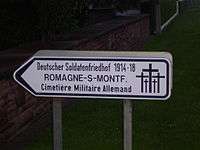 Distinctive sign seen throughout France and Belgium when indicating location of a German War Cemetery.
Distinctive sign seen throughout France and Belgium when indicating location of a German War Cemetery.- The Montfaucon column seen next to part of the nearby abbey ruins.

 The base of the Montfaucon monument.
The base of the Montfaucon monument.
Related articles
- List of World War I Memorials and Cemeteries in Alsace
- List of World War I memorials and cemeteries in Artois
- List of World War I memorials and cemeteries in Champagne-Ardennes
- List of World War I memorials and cemeteries in Flanders
- List of World War I Memorials and Cemeteries in Lorraine
- List of World War I memorials and cemeteries in the Somme
- List of World War I memorials and cemeteries in Verdun
- List of World War I memorials and cemeteries in the area of the St Mihiel salient
References
- The Meuse-Argonne American Cemetery Archived 11 February 2006 at the Wayback Machine American Battle Monuments Commission. Retrieved 7 February 2013
- Butte de Vauquois Archived 14 April 2013 at the Wayback Machine 2013 Site officiel de l'Office de Tourisme du Pays d'Argonne. Retrieved 29 January 2013
- Missouri First World War Monument at Cheppy Archived 4 July 2012 at the Wayback Machine Missourians in the First World War. Retrieved 31 January 2013
- The Montfaucon Monument Archived 16 September 2008 at the Wayback Machine The American Battle Monuments Commission. Retrieved 31 January 2013
- Pennsylvania Memorial www.webmatters.net. Retrieved 31 January 2013
- Pennsylvania Memorial Argonne1418. Retrieved 31 January 2013
- The Monument and Ossuary of La Haute Chevauchée Archived 20 August 2008 at the Wayback Machine Hellfire Corner. Retrieved 7 February 2013
- The Ossuaire de la Gruerie CNDP Reims. Retrieved 7 February 2013
- Romagne-sous-Montfaucon German Cemetery www.webmatters.net. Retrieved 7 February 2013
- The Kaiser Tunnel Archived 20 May 2013 at the Wayback Machine Verdun Tourism. Retrieved 7 February 2013